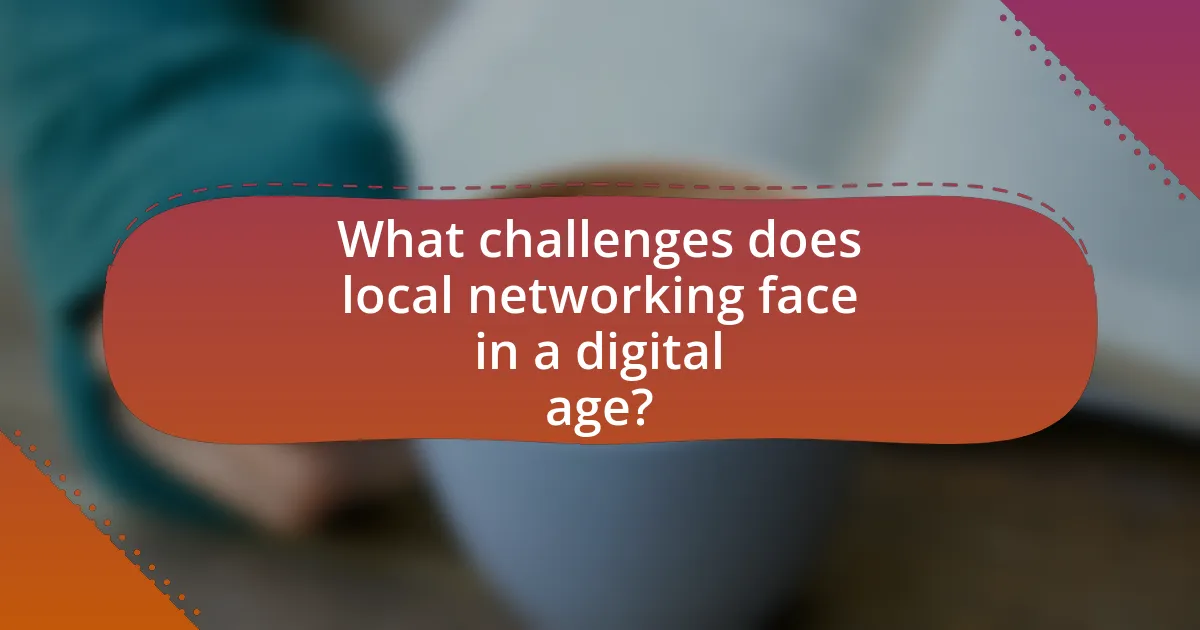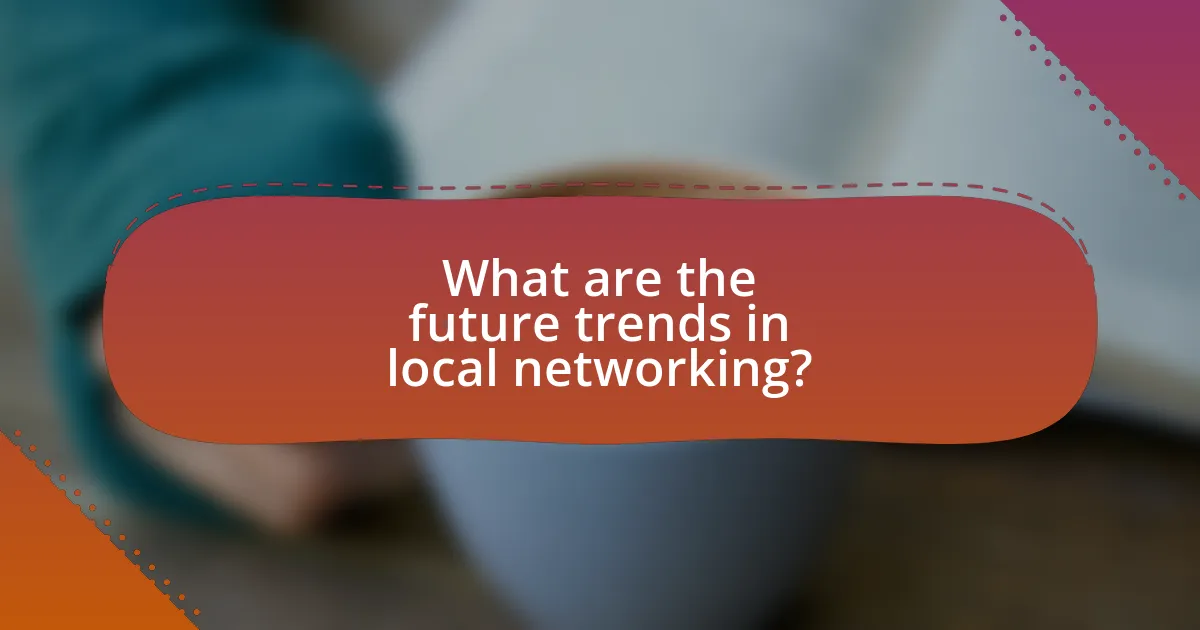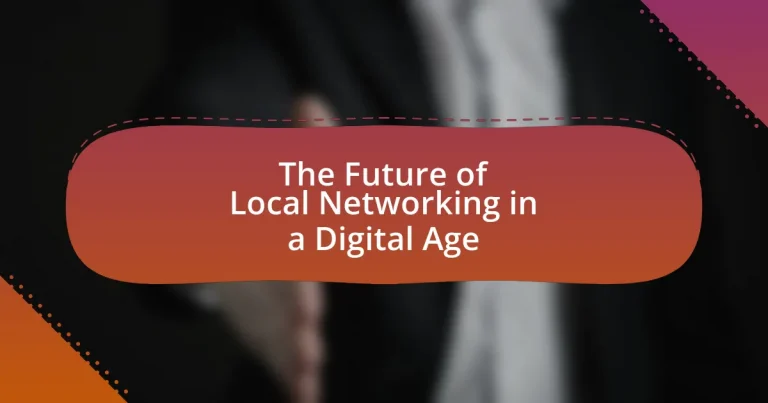The article examines the future of local networking in the context of advancing digital technologies, including 5G, Wi-Fi 6, and edge computing, which enhance connectivity and data processing. It highlights how these technologies facilitate seamless communication and collaboration, particularly through the Internet of Things (IoT) and social media platforms that foster community engagement. Additionally, the article addresses the challenges local networking faces, such as privacy concerns and misinformation, while exploring the role of artificial intelligence and virtual/augmented reality in shaping networking experiences. Key strategies for individuals and businesses to leverage digital tools for effective local networking are also discussed, emphasizing the importance of building trust and relationships within communities.

What is the Future of Local Networking in a Digital Age?
The future of local networking in a digital age is characterized by increased reliance on advanced technologies such as 5G, Wi-Fi 6, and edge computing, which enhance connectivity and data processing capabilities. These technologies enable faster, more reliable connections that support a growing number of devices and applications, facilitating seamless communication and collaboration within local networks. For instance, according to a report by the International Telecommunication Union, the deployment of 5G is expected to significantly improve local networking speeds and reduce latency, thereby transforming how businesses and communities interact digitally. Additionally, the rise of the Internet of Things (IoT) will further integrate local networks, allowing for smarter cities and homes where devices communicate efficiently, optimizing resource usage and enhancing user experiences.
How is local networking evolving with digital advancements?
Local networking is evolving through the integration of digital technologies that enhance connectivity and collaboration among community members. Digital advancements, such as social media platforms, mobile applications, and online forums, facilitate real-time communication and networking opportunities, allowing individuals and businesses to connect more efficiently. For instance, platforms like Meetup and Eventbrite enable users to organize and participate in local events, fostering community engagement and networking. According to a report by the Pew Research Center, 72% of adults use social media, which significantly contributes to local networking by allowing users to share resources, events, and opportunities within their communities. This shift towards digital tools is reshaping how local networks are formed and maintained, making them more accessible and dynamic.
What technologies are driving changes in local networking?
Technologies driving changes in local networking include Wi-Fi 6, Ethernet advancements, and software-defined networking (SDN). Wi-Fi 6 enhances speed and capacity, allowing more devices to connect simultaneously, which is crucial as the number of connected devices increases. Ethernet advancements, such as 10G and beyond, provide faster and more reliable wired connections, essential for high-bandwidth applications. Software-defined networking enables more flexible and efficient network management by decoupling the control plane from the data plane, allowing for dynamic adjustments to network traffic and resource allocation. These technologies collectively improve performance, scalability, and management of local networks, reflecting the evolving demands of a digital age.
How do social media platforms influence local networking?
Social media platforms significantly enhance local networking by facilitating connections among individuals and businesses within a specific geographic area. These platforms enable users to discover local events, join community groups, and engage with local businesses, thereby fostering a sense of community and collaboration. For instance, a study by the Pew Research Center found that 70% of adults use social media to connect with others in their local area, highlighting the role of these platforms in promoting local interactions. Additionally, features such as location tagging and local business pages allow users to easily find and support nearby services, further strengthening local ties.
Why is local networking important in a digital context?
Local networking is important in a digital context because it fosters community engagement and collaboration among individuals and businesses. This localized interaction enhances trust and relationships, which are crucial for effective communication and support in a digital landscape. According to a study by the Pew Research Center, 70% of adults believe that local connections are essential for building a strong community, highlighting the value of personal relationships in an increasingly digital world. Furthermore, local networking can lead to increased opportunities for collaboration, innovation, and resource sharing, which are vital for economic growth and resilience in local economies.
What role does local networking play in community building?
Local networking plays a crucial role in community building by fostering relationships and collaboration among individuals and organizations within a specific geographic area. These connections enhance social cohesion, facilitate resource sharing, and promote collective problem-solving, which are essential for a thriving community. Research indicates that communities with strong local networks experience increased civic engagement and improved quality of life, as evidenced by studies showing that neighborhoods with active social ties report higher levels of trust and cooperation among residents.
How does local networking enhance business opportunities?
Local networking enhances business opportunities by facilitating direct connections between entrepreneurs, potential clients, and industry peers. These connections often lead to collaborations, referrals, and partnerships that can significantly increase market reach and customer base. For instance, a study by the Kauffman Foundation found that 70% of small businesses rely on networking for growth, highlighting the importance of local relationships in driving sales and innovation. Additionally, local networking events provide platforms for sharing knowledge and resources, which can lead to new business ideas and strategies.

What challenges does local networking face in a digital age?
Local networking faces several challenges in a digital age, primarily due to the rise of online communication platforms that diminish the need for face-to-face interactions. The prevalence of social media and virtual networking tools has led to a decline in local engagement, as individuals often prefer digital connections over in-person meetings. According to a study by the Pew Research Center, 72% of adults use social media, which can create a sense of community online but often at the expense of local relationships. Additionally, the fast-paced nature of digital communication can lead to superficial connections, reducing the depth of local networking opportunities. Furthermore, the digital divide remains a significant barrier, as not all community members have equal access to technology, hindering inclusive local networking efforts.
How do privacy concerns affect local networking?
Privacy concerns significantly impact local networking by influencing user trust and participation. When individuals perceive risks related to data breaches or unauthorized access to personal information, they are less likely to engage in local networking activities. For instance, a survey by the Pew Research Center found that 81% of Americans feel they have little to no control over the data collected about them, which can deter them from using local networking platforms that require personal information. This hesitance can lead to reduced user engagement and limit the effectiveness of local networking initiatives, ultimately affecting community building and resource sharing.
What measures can be taken to protect user data in local networking?
To protect user data in local networking, implementing strong encryption protocols is essential. Encryption secures data transmitted over the network, making it unreadable to unauthorized users. For instance, using WPA3 for Wi-Fi security enhances protection against eavesdropping and brute-force attacks. Additionally, employing firewalls can help monitor and control incoming and outgoing network traffic, preventing unauthorized access. Regular software updates and patches are crucial as they fix vulnerabilities that could be exploited by attackers. Furthermore, educating users about safe practices, such as recognizing phishing attempts and using strong, unique passwords, significantly reduces the risk of data breaches. These measures collectively create a robust defense against potential threats in local networking environments.
How do misinformation and digital noise impact local networking?
Misinformation and digital noise significantly hinder local networking by creating confusion and distrust among community members. When individuals encounter false information or irrelevant content, their ability to form genuine connections is compromised, leading to skepticism about the reliability of local resources and events. A study by the Pew Research Center found that 64% of Americans believe that misinformation has a major impact on their ability to engage with their communities effectively. This erosion of trust can result in decreased participation in local initiatives and events, ultimately stifling community cohesion and collaboration.
What are the barriers to effective local networking?
Barriers to effective local networking include lack of trust, limited access to resources, and insufficient communication channels. Lack of trust can hinder relationship-building, as individuals may be reluctant to engage with others without established credibility. Limited access to resources, such as venues or technology, restricts opportunities for networking events and interactions. Insufficient communication channels, including outdated platforms or lack of awareness about local networking opportunities, can prevent individuals from connecting effectively. These barriers collectively impede the potential for collaboration and community engagement in local networking efforts.
How does technology accessibility influence local networking?
Technology accessibility significantly enhances local networking by enabling broader participation and collaboration among community members. When technology is readily available, individuals can easily connect through various platforms, facilitating the exchange of ideas and resources. For instance, studies show that communities with high internet access experience increased social interactions and networking opportunities, as individuals can utilize social media, online forums, and local apps to engage with one another. This connectivity fosters a sense of community and encourages local businesses to collaborate, ultimately driving economic growth and innovation within the area.
What cultural factors can hinder local networking efforts?
Cultural factors that can hinder local networking efforts include communication styles, social norms, and trust levels within communities. For instance, in cultures where indirect communication is preferred, individuals may struggle to express their intentions clearly, leading to misunderstandings and missed networking opportunities. Additionally, social norms that prioritize individualism over collectivism can create barriers, as people may be less inclined to engage in collaborative networking. Trust levels also play a critical role; in cultures where trust is built over time, immediate networking efforts may be perceived as insincere or transactional, discouraging participation. These factors collectively impact the effectiveness of local networking initiatives.

What are the future trends in local networking?
Future trends in local networking include the increased adoption of Wi-Fi 6 and 6E technologies, which offer higher speeds and improved capacity for connected devices. These advancements are driven by the growing demand for seamless connectivity in smart homes and businesses. Additionally, the integration of edge computing is expected to enhance local networking by processing data closer to the source, reducing latency and improving response times. The rise of mesh networking systems will also facilitate better coverage and reliability in local environments, allowing for more robust connections across multiple devices. According to a report by the International Data Corporation (IDC), the global market for Wi-Fi 6 is projected to reach $5.5 billion by 2025, underscoring the significant shift towards these technologies in local networking.
How will artificial intelligence shape local networking?
Artificial intelligence will significantly enhance local networking by optimizing connectivity and improving user experiences. AI algorithms can analyze local network traffic patterns, enabling more efficient data routing and reducing latency. For instance, AI-driven tools can predict network congestion and automatically adjust bandwidth allocation, ensuring smoother communication among devices. Additionally, AI can facilitate personalized networking experiences by analyzing user preferences and behaviors, leading to tailored content delivery and improved engagement. This is evidenced by studies showing that AI-enhanced networks can increase operational efficiency by up to 30%, demonstrating its transformative impact on local networking.
What are the potential applications of AI in local networking?
AI can enhance local networking through applications such as network optimization, security monitoring, and predictive maintenance. Network optimization involves using AI algorithms to analyze traffic patterns and dynamically allocate resources, improving overall performance. Security monitoring leverages AI to detect anomalies and potential threats in real-time, significantly reducing the risk of breaches. Predictive maintenance utilizes AI to analyze device performance data, allowing for proactive repairs and minimizing downtime. These applications demonstrate AI’s capability to improve efficiency, security, and reliability in local networking environments.
How can AI improve user engagement in local networking?
AI can improve user engagement in local networking by personalizing interactions and enhancing connectivity among users. By analyzing user data, AI algorithms can identify preferences and suggest relevant local events, groups, or individuals, thereby fostering meaningful connections. For instance, platforms like Meetup utilize AI to recommend gatherings based on user interests, leading to increased participation rates. Additionally, AI-driven chatbots can facilitate real-time communication, answering queries and providing information about local networking opportunities, which further encourages user involvement. Studies show that personalized recommendations can increase user engagement by up to 50%, demonstrating the effectiveness of AI in enhancing local networking experiences.
What role will virtual and augmented reality play in local networking?
Virtual and augmented reality will significantly enhance local networking by creating immersive environments for interaction and collaboration. These technologies enable users to engage in virtual spaces that replicate physical presence, facilitating real-time communication and shared experiences. For instance, platforms like Spatial and Gather allow users to meet in virtual rooms, fostering networking opportunities that transcend geographical limitations. Research indicates that immersive experiences can increase engagement and retention rates by up to 70%, demonstrating the effectiveness of virtual and augmented reality in enhancing local networking dynamics.
How can VR and AR enhance local networking experiences?
VR and AR can enhance local networking experiences by creating immersive environments that facilitate real-time interactions among participants. These technologies allow users to engage in virtual spaces that replicate physical settings, enabling more dynamic and engaging networking opportunities. For instance, a study by PwC found that VR training can increase retention rates by up to 75%, demonstrating the effectiveness of immersive experiences in fostering connections. Additionally, AR applications can overlay digital information onto the physical world, allowing users to share and access relevant data seamlessly during networking events. This integration of digital and physical interactions not only enriches the networking experience but also promotes deeper engagement and collaboration among local participants.
What are the challenges of implementing VR and AR in local networking?
The challenges of implementing VR and AR in local networking include bandwidth limitations, latency issues, and interoperability concerns. Bandwidth limitations can hinder the transmission of high-quality VR and AR content, as these technologies require substantial data throughput to function effectively. Latency issues can lead to delays in user interactions, which can disrupt the immersive experience that VR and AR aim to provide. Interoperability concerns arise from the need for different devices and platforms to work seamlessly together, which can complicate the integration of VR and AR applications into existing local networks. These challenges are supported by studies indicating that high data rates and low latency are critical for effective VR and AR experiences, as highlighted in research by the International Telecommunication Union.
What best practices can enhance local networking in a digital age?
Utilizing social media platforms effectively enhances local networking in a digital age. Engaging with community groups on platforms like Facebook or LinkedIn allows individuals to connect with local professionals, share resources, and participate in discussions relevant to their area. According to a 2021 report by the Pew Research Center, 69% of adults in the U.S. use social media, making it a powerful tool for fostering local connections. Additionally, attending virtual events or webinars can facilitate networking opportunities, as these platforms often allow for real-time interaction and follow-up discussions, further strengthening local ties.
How can individuals effectively leverage digital tools for local networking?
Individuals can effectively leverage digital tools for local networking by utilizing platforms such as LinkedIn, Meetup, and Facebook Groups to connect with local professionals and communities. These platforms allow users to join interest-based groups, attend virtual events, and engage in discussions, thereby facilitating meaningful connections. For instance, LinkedIn reports that 80% of professionals consider networking essential for career success, highlighting the importance of digital networking in local contexts. Additionally, Meetup has over 49 million members globally, showcasing its effectiveness in bringing people together based on shared interests. By actively participating in these digital spaces, individuals can enhance their local networking opportunities and build valuable relationships.
What strategies can businesses adopt to foster local networking?
Businesses can adopt strategies such as hosting community events, leveraging social media platforms, and forming partnerships with local organizations to foster local networking. Hosting community events, such as workshops or meetups, allows businesses to engage directly with local residents and other businesses, creating opportunities for collaboration and relationship-building. Utilizing social media platforms, particularly those focused on local connections, enables businesses to reach a wider audience and interact with community members in real-time. Forming partnerships with local organizations, such as chambers of commerce or non-profits, can enhance visibility and credibility while providing access to established networks. These strategies are effective as they encourage face-to-face interactions and build trust within the community, essential components of successful networking.




